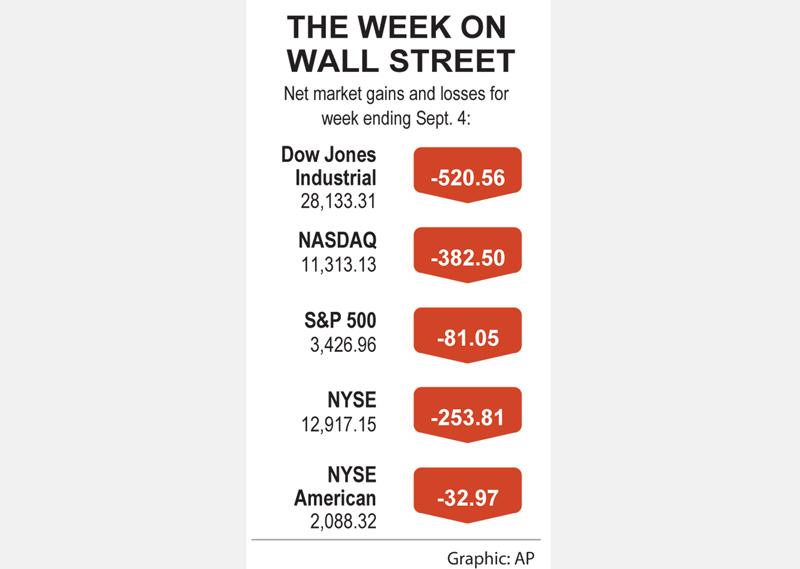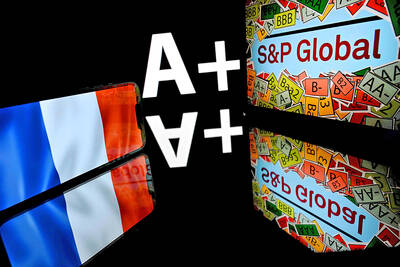The NASDAQ Composite closed lower on Friday, although well above its session low as selling eased late in the day after investors dumped heavyweight technology stocks due to concerns about high valuations and a patchy economic recovery.
The major indices regained some ground in late afternoon, although trading was still volatile.
At its lowest point of the day the tech-heavy NASDAQ fell as much as 9.9 percent from its record high reached on Wednesday and the S&P 500 dipped briefly below its pre-crisis record, reached in February, although it too closed well off session lows.

Mega-cap companies, such as Apple Inc Microsoft Inc, Amazon.com Inc and Facebook Inc, also pared losses, although of that group only Apple managed a very tiny gain for the day.
“You had a significant selloff on Thursday, some follow-through in the morning and then we stabilized. The selling was pretty fierce,” said Michael Antonelli, market strategist at Robert W. Baird & Co in Milwaukee.
“Corrections like this have been quick and severe lately. We don’t know if its over,” he said. “The fact we stabilized today could be a good sign.”
While Thursday’s selloff already reflected investor fears that valuations for the NASDAQ high-fliers had overheated, the worries were exacerbated on Friday by the Financial Times (FT) and others reporting that options trading by Japan’s Softbank Group Corp had inflated these stocks.
“We’ve started to see signs of weakness in the last few days, notably yesterday. Then you get a headline like the FT story. That really adds fuel to the fire on the downside,” said Jeffrey Kleintop, chief global investment strategist at Charles Schwab Corp in Boston.
The NASDAQ had powered the stock market’s stellar recovery from the pandemic-led crash, climbing as much as 82 percent from March lows.
The benchmark S&P 500 and the Dow Jones Industrial Average had surged about 60 percent from their troughs.
Earlier on Friday, the US Department of Labor’s closely watched employment report showed that the unemployment rate last month improved to 8.4 percent from 10.2 percent in July, better than analysts had anticipated. However, non-farm payrolls increased less than expected.
Kleintop said that the jobs news did little to help the progress of stalled talks for a fresh COVID-19 stimulus package among sharply divided lawmakers in Washington.
“It wasn’t wonderful enough to get the market excited enough that we don’t need any more stimulus. On the other hand it wasn’t weak enough to bring the two sides in Washington together to extend that stimulus package,” he said.
The Dow Jones Industrial Average on Friday fell 159.42 points, or 0.56 percent, to close at 28,133.31, the S&P 500 lost 28.1 points, or 0.81 percent, to 3,426.96 and the NASDAQ Composite dropped 144.97 points, or 1.27 percent, to 11,313.13.
The communication services, consumer discretionary and technology indexes posted the day’s steepest percentage declines among the 11 major S&P sectors.
Only three S&P sectors ended the day higher, including financials, which was powered by a 2.2 percent gain in its bank sub-sector index.
Also, the S&P 1500 airlines sub-index rose 1.85 percent for the day.
For the week, the S&P 500 fell 2.31 percent after five consecutive weeks of gains. The Dow dropped 1.82 percent and the NASDAQ lost 3.27 percent, and clocked its biggest two-day drop since March 17 between Thursday and Friday.
Some fund managers have warned that the declines could be a preview of a rocky two months ahead of the Nov. 3 US presidential election, as institutional investors return from summer vacations and also refocus on potential economic pitfalls.
Wall Street’s fear gauge, after hitting a more than 11-week high in late morning trading, ended the day lower.
Broadcom Inc gained 3 percent after the Apple supplier forecast fourth-quarter revenue above analysts’ estimates.
Declining issues outnumbered advancing ones on the New York Stock Exchange by a 1.53-to-1 ratio; on NASDAQ, a 1.63-to-1 ratio favored decliners.
The S&P 500 posted no new 52-week highs and 1 new low; the NASDAQ Composite recorded 21 new highs and 88 new lows.
On US exchanges 11.31 billion shares changed hands, compared with the 9.29 billion average for the past 20 sessions.

France cannot afford to ignore the third credit-rating reduction in less than a year, French Minister of Finance Roland Lescure said. “Three agencies have downgraded us and we can’t ignore this cloud,” he told Franceinfo on Saturday, speaking just hours after S&P lowered his country’s credit rating to “A+” from “AA-” in an unscheduled move. “Fundamentally, it’s an additional cloud to a weather forecast that was already pretty gray. It’s a call for lucidity and responsibility,” he said, adding that this is “a call to be serious.” The credit assessor’s move means France has lost its double-A rating at two of the

AI BOOST: Although Taiwan’s reliance on Chinese rare earth elements is limited, it could face indirect impacts from supply issues and price volatility, an economist said DBS Bank Ltd (星展銀行) has sharply raised its forecast for Taiwan’s economic growth this year to 5.6 percent, citing stronger-than-expected exports and investment linked to artificial intelligence (AI), as it said that the current momentum could peak soon. The acceleration of the global AI race has fueled a surge in Taiwan’s AI-related capital spending and exports of information and communications technology (ICT) products, which have been key drivers of growth this year. “We have revised our GDP forecast for Taiwan upward to 5.6 percent from 4 percent, an upgrade that mainly reflects stronger-than-expected AI-related exports and investment in the third

Mercuries Life Insurance Co (三商美邦人壽) shares surged to a seven-month high this week after local media reported that E.Sun Financial Holding Co (玉山金控) had outbid CTBC Financial Holding Co (中信金控) in the financially strained insurer’s ongoing sale process. Shares of the mid-sized life insurer climbed 5.8 percent this week to NT$6.72, extending a nearly 18 percent rally over the past month, as investors bet on the likelihood of an impending takeover. The final round of bidding closed on Thursday, marking a critical step in the 32-year-old insurer’s search for a buyer after years of struggling to meet capital adequacy requirements. Local media reports

RARE EARTHS: The call between the US Treasury Secretary and his Chinese counterpart came as Washington sought to rally G7 partners in response to China’s export controls China and the US on Saturday agreed to conduct another round of trade negotiations in the coming week, as the world’s two biggest economies seek to avoid another damaging tit-for-tat tariff battle. Beijing last week announced sweeping controls on the critical rare earths industry, prompting US President Donald Trump to threaten 100 percent tariffs on imports from China in retaliation. Trump had also threatened to cancel his expected meeting with Chinese President Xi Jinping (習近平) in South Korea later this month on the sidelines of the APEC summit. In the latest indication of efforts to resolve their dispute, Chinese state media reported that